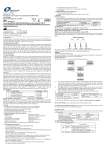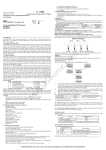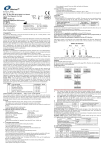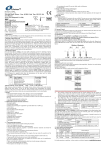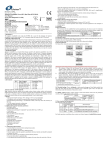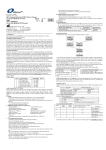Transcript
Revision No.: ZJ0007 Issue Date: Jul 1st, 2012 Enterovirus 71(EV71) Real Time RT-PCR Kit User Manual For In Vitro Diagnostic Use Only QR-0205-01 For use with LightCycler1.0/2.0 Instrument Obelis S.A. Boulevard Général Wahis 53 1030 Brussels, BELGIUM Tel: +(32) 2.732.59.54 Fax: +(32) 2.732.60.03 E-Mail : [email protected] Shanghai ZJ Bio-Tech Co., Ltd. www.liferiver.com.cn Tel: +86-21-34680596 [email protected] Fax: +86-21-34680595 nd 2 floor,No.15 Building,No.188 Xinjunhuan Road, PuJiang Hi-tech Park, Shanghai, China 1. Intended Use By using real time PCR systems, Enterovirus 71 real time PCR kit is used for the detection of Enterovirus 71 in samples like nasal and pharyngeal secretions, sputum, provoked sputum, stool, C.S.F , serum and etc. 2. Principle of Real-Time PCR The principle of the real-time detection is based on the fluorogenic 5’nuclease assay. During the PCR reaction, the DNA polymerase cleaves the probe at the 5’ end and separates the reporter dye from the quencher dye only when the probe hybridizes to the target DNA. This cleavage results in the fluorescent signal generated by the cleaved reporter dye, which is monitored real-time by the PCR detection system. The PCR cycle at which an increase in the fluorescence signal is detected initially is proportional to the amount of the specific PCR product. Monitoring the fluorescence intensities in real-time allows the detection of the accumulating product without having to re-open the reaction tube after the amplification. 3. Product Description Enterovirus 71 (EV71), one of the major causative agents for hand, foot and mouth disease (HFMD), is sometimes associated with severe central nervous system diseases. In 1997, in Malaysia and Japan, and in 1998 in Taiwan, there were HFMD epidemics involving sudden deaths among young children, and EV71 was isolated from the HFMD patients, including the fatal cases. The nucleotide sequences of each EV71 isolate were determined and compared by phylogenetical analysis. EV71 strains from previously reported epidemics belonged to genotype A-1, while those from recent epidemics could be divided into two genotypes, A-2 and B. The Enterovirus 71 real time RT-PCR kit contains a specific ready-to-use system for the detection of the Enterovirus 71 using RT-PCR (Reverse Transcription Polymerase Chain Reaction) in the real-time PCR system. The master contains a Super Mix for the specific amplification of the Enterovirus 71 RNA. The reaction is done in one step real time RT-PCR. The first step is a reverse transcription (RT), during which the Enterovirus 71 RNA is transcribed into cDNA. Afterwards, a thermostable DNA polymerase is used to amplify the specific gene fragments by means of PCR (polymerase chain reaction). Fluorescence is emitted and measured by the real time systems´ optical unit during the PCR. The detection of amplified Enterovirus 71 DNA fragment is performed in fluorimeter channel 530nm with the fluorescent quencher BHQ1. An external positive control defined as 1×107copies/ml is supplied which allow the determination of the gene load. For further information, please refer to section 9.3 Quantitation. 4. Kit Contents Ref. Type of reagent Presentation 25rxns 1 EV71 Super Mix 1 vial, 380ml 2 RT-PCR Enzyme Mix 1 vial, 28ml 3 Molecular Grade Water 1 vial, 400µl 7 4 EV71 Positive Control (1×10 copies/ml) 1 vial, 30µl 3 4 Analysis sensitivity: 5×10 copies/ml LOQ:1×10 ~1×108 copies/ml Note: Analysis sensitivity depends on the sample volume, elution volume, nucleic acid extraction methods and other factors .If you use the RNA extraction kits recommended, the analysis sensitivity is the same as it declares. However, when the sample volume is dozens or even hundreds of times greater than elution volume by some concentrating method, it can be much higher. 5. Storage • All reagents should be stored at -20°C. Storage at +4°C is not recommended. • All reagents can be used until the expiration date indicated on the kit label. • Repeated thawing and freezing (>3x) should be avoided, as this may reduce the sensitivity of the assay. • Cool all reagents during the working steps. • Super Mix should be stored in the dark. 6. Additionally Required Materials and Devices • Biological cabinet • Real time PCR system • Desktop microcentrifuge for “eppendorf” type tubes (RCF max. 16,000 x g) • Vortex mixer • RNA extraction kit • Real time PCR reaction tubes/plates • Cryo-container • Pipets (0.5 µl – 1000 µl) • Sterile filter tips for micro pipets • Sterile microtubes • Disposable gloves, powderless • Biohazard waste container • Refrigerator and Freezer • Tube racks 7. Warnings and Precaution • Carefully read this instruction before starting the procedure. • For in vitro diagnostic use only. • This assay needs to be carried out by skilled personnel. • Clinical samples should be regarded as potentially infectious materials and should be prepared in a laminar flow hood. • This assay needs to be run according to Good Laboratory Practice. • Do not use the kit after its expiration date. • Avoid repeated thawing and freezing of the reagents, this may reduce the sensitivity of the test. • Once the reagents have been thawed, vortex and centrifuge briefly the tubes before use. • Prepare quickly the Reaction mix on ice or in the cooling block. • Set up two separate working areas: 1) Isolation of the RNA/ DNA and 2) Amplification/ detection of amplification products. • Pipets, vials and other working materials should not circulate among working units. • Use always sterile pipette tips with filters. • Wear separate coats and gloves in each area. • Do not pipette by mouth. Do not eat, drink, and smoke in laboratory. • Avoid aerosols. 8. Sample Collection, Storage and Transport • Collected samples in sterile tubes. • Specimens can be extracted immediately or frozen at -20°C to -80°C. • Transportation of clinical specimens must comply with local regulations for the transport of etiologic agents. 9. Procedure 9.1 RNA-Extraction Different brands of RNA extraction kits are available. You may use your own extraction systems or the commercial kit based on the yield. For RNA extraction kit, please comply with manufacturer’s instructions. The recommended extraction kit is as follows: Nucleic Acid Isolation Kit Cat. Number Manufacturer RNA Isolation Kit ME-0010/ME-0012 ZJ Biotech QIAamp Viral RNA Mini Extraction Kit (50) 52904 QIAGEN 9.2 Quantitation The kit can be used for quantitative or qualitative real-time RT-PCR detection. For performance of quantitative real-time PCR, standard dilutions must be prepared firstly as follows. Molecular Grade Water is used as the dilution. Dilution is not needed for performance of qualitative real-time PCR detection. Take positive control (1×107copies/ml) as the starting high standard in the first tube. Respectively pipette 36ul Molecular Grade Water into next three tubes. Do three dilutions as the following figures: To generate a standard curve on the real-time system, all four dilution standards should be used and defined as standard with specification of the corresponding concentrations. Attention: A. Mix thoroughly before next transfer. B. The positive control contains high concentration of the target DNA. Therefore, be careful of the dilution in order to avoid contamination. 9.3 RT-PCR Protocol The Master Mix volume for each reaction should be pipetted as follows: 1) The volumes of Super Mix and Enzyme Mix per reaction multiply with the number of samples, which includes the number of controls, standards, and sample prepared. Molecular Grade Water is used as the negative control. For reasons of unprecise pipetting, always add an extra virtual sample. Mix completely then spin down briefly in a centrifuge. 2) Pipet 15µl Master Mix with micropipets in sterile filter tips to each real time PCR reaction plate/tubes. Separately add 5µl RNA sample, positive and negative controls to different reaction plate/tubes. Immediately close the plate/tubes to avoid contamination. 3) Spin down briefly in order to collect the Master Mix in the bottom of the reaction tubes. 4) Perform the following protocol in the instrument: 45°C for 10min 1cycle Selection of fluorescence channels 95°C for 15min 1cycle 530nm Target Nucleic Acid 95°C for 5sec, 60°C for 30sec 40cycles ( Fluorescence measured at 60°C) 10. Threshold setting: Choose Arithmetic as back ground and none as Noise Band method, then adjust the Noise band just above the maximum level of molecular grade water, and adjust the threshold just under the minimum of the positive control. 11. Calibration for quantitative detection: Input each concentration of standard controls at the end of run, and a standard curve will be automatically formed. 12. Quality control: Negative control, positive control and QS curve must be performed correctly, otherwise the sample results is invalid. Channel Crossing point value Control 530nm Molecular Grade Water Blank Positive Control(qualitative assay) ≤35 QS(quantitative detection) Correlation coefficient of QS curve≤-0.98 13. Data Analysis and Interpretation The following sample results are possible: Crossing point value Result Analysis 530nm 1# Blank Below the detection limit or negative 2# ≤38 Positive; and the software displays the quantitative value 3# Re-test; if it is still 38~40, report as 1# 38~40 For further questions or problems, please contact our technical support at [email protected]
